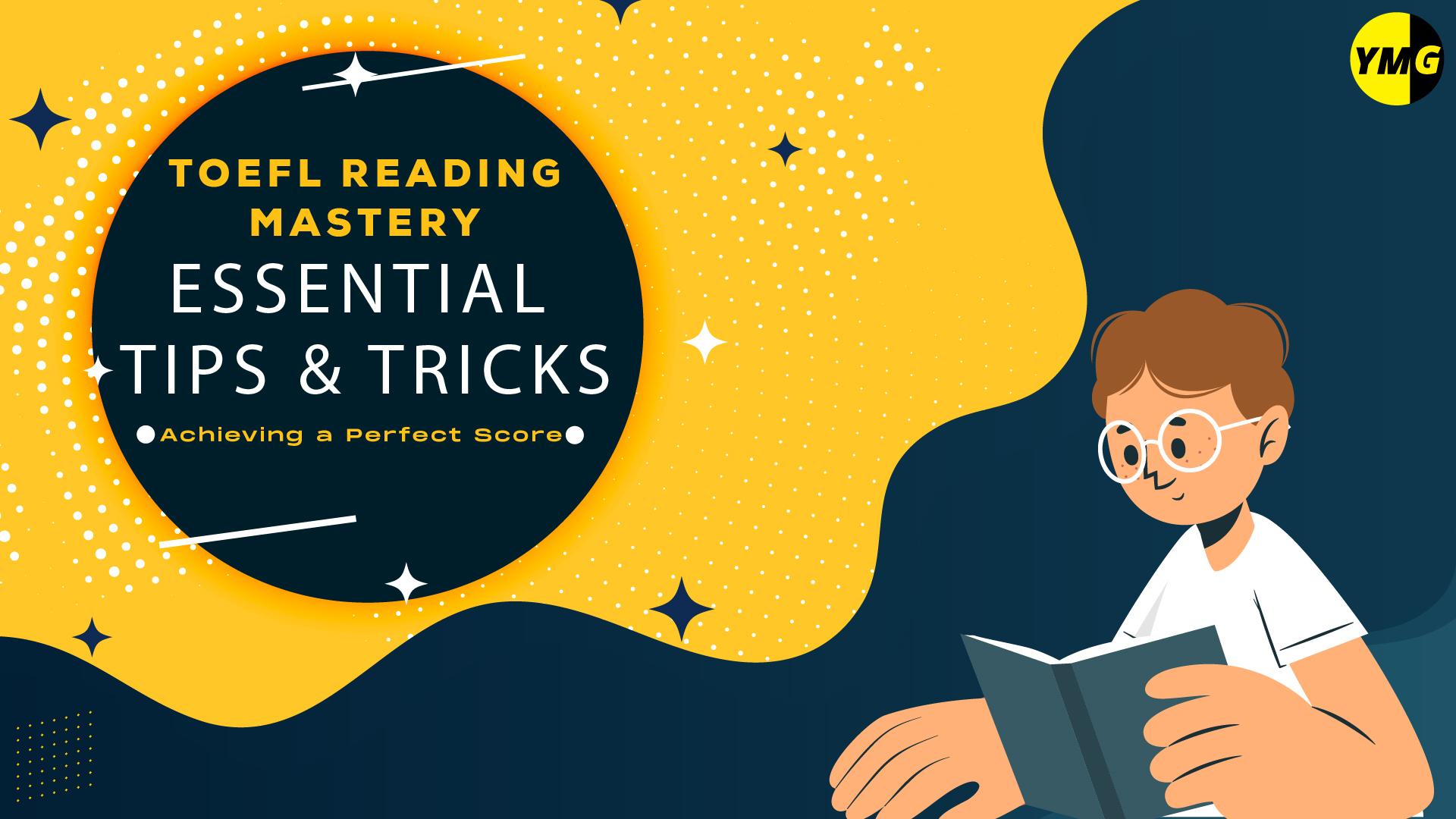Tips and Strategies to score 30 in TOEFL Reading


The TOEFL (Test of English as a Foreign Language) is an English proficiency test widely used for university admissions and visa purposes. It assesses your ability to understand and use English in academic settings. The test consists of four sections: Reading, Listening, Speaking, and Writing. Scores range from 0 to 120, with each section scored on a scale of 0 to 30.
It's essential to familiarize yourself with the reading format first. So, let's dive in.
| Component | Description |
| Number of Passages | 2 (Each approximately 700 words long) |
| Number of Questions | 10 questions per passage |
| Total Number of Questions | 20 |
| Time Limit | 35 minutes (including both passages) |
| Passage Types | Academic passages from textbooks, articles, essays, etc. |
Achieving a perfect score of 30 in the TOEFL Reading section requires strong English language skills and effective test-taking strategies. Here are some tips and tricks that you can follow to ace your reading section.
1. Understand the format
Familiarize yourself with the different question types in the Reading section, such as multiple-choice questions and summary tasks. In the updated TOEFL version, there are now only two reading passages, with ten questions for each passage, totaling 20. You have 35 minutes to solve them. It's crucial to memorize the question types, understand how much time to allocate for each question, and be familiar with the order in which the questions are presented. This way, you can manage your time wisely and confidently approach each question.
Let's take an example of a multiple-choice question from a TOEFL Reading passage and walk through the solution:
Example
Read the following passage:
Extract
"In the 19th century, the Industrial Revolution brought significant societal changes. Factories emerged, transforming the way goods were produced. This period marked a shift from agrarian economies to industrialized ones, leading to urbanization and a rise in technological innovations."
Question
What is the main idea of the passage?
A) The rise of agrarian economies
B) Technological innovations in the 19th century
C) The impact of the Industrial Revolution on society
D) The emergence of factories in urban areas
Solution
We need to identify the passage's main idea to answer this multiple-choice question. Let's analyze each option:
A) The rise of agrarian economies - This is not the main idea of the passage; it's mentioned as something that changed during the Industrial Revolution.
B) Technological innovations in the 19th century - While technological innovations are mentioned, they are not the central theme of the passage.
C) The impact of the Industrial Revolution on society - This is the correct answer. The passage discusses how the Industrial Revolution brought about significant changes in society.
D) The emergence of factories in urban areas - This is a specific detail mentioned in the passage but doesn't capture the broader impact discussed in the main idea.
By understanding the question type (multiple-choice) and the need to identify the main idea, you can efficiently eliminate incorrect options and choose the most appropriate answer (Option C) to maximize your score within the given time frame.
2. Practice without a timer initially
Begin practicing without a timer initially. You can learn without feeling pressured when you don't use the timer. Focus on understanding the strategies and how to answer the test questions. Once you grasp everything, you can practice with a timer.
Here's our step-to-step guide of how you can practice the reading section for TOEFL originally without a timer:
Choose a Reading Passage
Select a TOEFL reading passage. You can find such passages in TOEFL preparation books or online resources.
Read the Passage Thoroughly
Take your time to read the passage without any time constraints. Focus on understanding the main ideas, supporting details, and the overall structure of the passage.
Annotate and Summarize
Annotate the passage as you read. Underline key information, jot down notes, and summarize each paragraph in your own words. This helps reinforce your understanding.
Answer the Questions Without Time Pressure
Answer the associated questions without worrying about time. Refer to the passage for each question and choose the best answer based on your comprehension of the content. Practicing without a timer allows you to thoroughly engage with the passage and questions, reinforcing your understanding of the strategies needed to excel in the TOEFL Reading section. As you become more comfortable, you can gradually introduce time constraints to simulate test conditions.
3. Do not read the entire passage at first
The TOEFL Reading passages are usually long, and reading the whole thing at the beginning takes up much time. It's better to quickly skim through the passage to understand the main points and structure. This way, you can be more thoughtful when answering questions and finding the necessary details.
Here's how you can implement this technique:
Begin by reading the introduction and conclusion of the passage. These sections often provide a summary of the main ideas. Understanding the passage's purpose and conclusion can give you a framework for approaching the detailed questions.
Quickly scan each paragraph for topic sentences. These sentences usually express the main idea of the paragraph. By identifying them, you gain a quick understanding of the overall structure and flow of the passage.
While skimming, pay attention to keywords and phrases. These might include names, dates, locations, or any terms that stand out. Noting these can help you locate specific noteworthy termsinformation more efficiently when answering questions.
Keep an eye out for signal words that indicate relationships between ideas, such as "however," "therefore," or "in contrast." Understanding how ideas are connected can aid in comprehending the author's argument.
By skimming the passage, you can quickly identify key points and more efficiently locate the information needed to answer questions accurately. This approach helps you manage your time effectively.
4. Strategy
Be attentive to details in the passage, especially when answering questions that require specific information.
You can do this by:
1. Carefully reading the passage
2. Locating relevant information in the passage
3. Verifying answer choices
4. Using the process of elimination
Example
Consider the following passage piece
"The biodiversity of rainforests is unparalleled, housing a vast array of plant and animal species. These ecosystems play a crucial role in maintaining environmental balance. However, deforestation poses a significant threat to rainforest biodiversity, leading to habitat loss and the endangerment of numerous species."
Question:
What is identified as a significant threat to rainforest biodiversity in the passage?
A) The importance of rainforests in environmental balance
B) The vast array of plant and animal species in rainforests
C) The role of rainforests in maintaining biodiversity
D) The impact of deforestation on rainforest biodiversity
Solution
The importance of rainforests in environmental balance: This is mentioned but doesn't directly address the threat to biodiversity. ❌
The vast array of plant and animal species in rainforests: This is a general statement about rainforest biodiversity but doesn't address the threat. ❌
The role of rainforests in maintaining biodiversity: This is a broader statement about the general role of rainforests but doesn't pinpoint the threat. ❌
The impact of deforestation on rainforest biodiversity: This is the correct answer. The passage explicitly states that deforestation poses a significant threat to rainforest biodiversity. ✅
By being attentive to details and using the process of elimination, you can confidently select the correct answer based on the information presented in the passage. This strategy helps you look at the questions efficiently and increases your accuracy in the TOEFL Reading section.
5. Do not get stuck on a question
If you're unsure about the answer, don't spend too much time on it. Move on because there might be more straightforward questions later that you can answer, and you can come back to the difficult one later.
For example, if the challenging question was about a specific detail in a scientific passage and you later encounter a question asking about the main idea of the passage, answering the latter question might provide you with a better grasp of the content, making it easier to return to the challenging question.
This approach helps you manage your time effectively, maximize your chances of answering easier questions, and gives you the opportunity to revisit challenging questions with a fresh perspective later in the test.
6. Time Management
To allocate enough time for each passage and its associated questions, practice time management. Please don't spend too much time on a single question.
Situation
Let's say you find a particularly challenging question in Passage 1 that you can't quickly resolve. In this situation, it's crucial not to spend more than 1.5 minutes on that question. Mark it and move forward, ensuring you have sufficient time for the remaining questions in both passages. This strategic approach maximizes your chances of completing the section and answering a higher number of questions accurately within the given timeframe.
7. The questions are in order of the passage
The questions follow the order of the passage. So, question number 1 is originally related to paragraphs 1 and 2; similarly, question 2 will pertain to paragraphs 2 or 3.
Have a look at the passage below to get a clear idea!
Passage:
"The evolution of smartphones has revolutionized communication. In the early 2000s, mobile phones were primarily used for calls and text messages. However, with the advent of smartphones, communication expanded to include multimedia messaging, internet browsing, and a myriad of applications."
Questions:
1. What were mobile phones primarily used for in the early 2000s?
2. How did smartphones expand communication capabilities?
Solution:
Answering Question 1:
-
-
Since question number 1 is related to paragraphs 1 and 2, focus on information within those paragraphs. The passage mentions that in the early 2000s, mobile phones were primarily used for calls and text messages. Therefore, the answer is that mobile phones were primarily used for calls and text messages.
-
Answering Question 2:
-
-
Now, move on to question 2, which connects to paragraphs 2 or 3. Look for information about how smartphones expanded communication capabilities. In paragraph 2, the passage discusses how smartphones introduced multimedia messaging, internet browsing, and various applications. Therefore, the answer is that smartphones expanded communication capabilities by introducing multimedia messaging, internet browsing, and various applications.
-
This example illustrates how the questions follow the order of the passage, guiding you to specific paragraphs for relevant information. By understanding this pattern, you can efficiently locate answers and save valuable time during the TOEFL Reading section.
8. Vocabulary
You can improve your vocabulary skills, as some questions may involve understanding the meaning of specific words or phrases in context.
You can incorporate the following strategies to enhance your vocabulary:
Regular reading exposes you to a diverse range of vocabulary. Include various genres such as articles, essays, newspapers, and academic texts.
Create flashcards with new words, their meanings, and sample sentences. Review them regularly to reinforce your memory.
Educational videos, documentaries, and TED talks cover a wide range of topics and often use advanced vocabulary. Pay attention to how words are used in spoken language.
Use official TOEFL preparation materials and resources. These often include vocabulary lists and exercises specifically designed for the test.
9. Practice Regularly
Make regular practice an important part of your TOEFL preparation. Aim to complete at least 5 mock tests, and you'll find many materials available online. Consider signing up with us to access TOEFL material sent directly to your email. These resources will be invaluable in mastering the TOEFL and boosting your confidence for the exam.
10. Review Mistakes
After practice sessions, review your mistakes. Understand why you got a question wrong and learn from it. This reflective process can help you avoid similar errors in the actual test.
Remember, achieving a perfect score takes time and effort. Focus on improving your English proficiency; the Reading section score will likely follow.
Frequently Asked Questions!

The TOEFL Reading Section assesses your English reading comprehension to ensure you possess the proficiency required for an English-speaking environment, such as a university classroom or campus setting.

Scan for specific details in the text related to the questions by paying attention to keywords and phrases in both the questions and the passage. Consider spending about 20 minutes on each passage, leaving a few minutes at the end for reviewing and revisiting any challenging questions.

In the updated TOEFL version, there are now only 2 reading passages.

There are 10 questions for each reading passage, totaling 20 questions for the entire reading section.

TOEFL is primarily used for academic English, while IELTS assesses a broader range of language skills, including academic and general English.

The time is generally not explicitly divided between the two passages. You need to manage your time efficiently to read and answer questions for both passages within the 35-minute timeframe.

If you get stuck on a question, the TOEFL iBT test allows you to skip that particular one and return to it later. Remember to go back and answer those questions before the time runs out for answering the Reading section.

In the TOEFL Reading section, you'll read about different subjects like science, social studies, business, and the arts. It covers a wide range of topics you might find in school.

Focus on honing your reading skills, comprehension, and time management. Practice with materials that reflect the new format, and be familiar with the types of questions you will be asked to answer. You can refer to the official TOEFL website for resources and guidelines for the most accurate and current information regarding the test format and content.

While TOEFL exams are generally offered year-round, the availability of specific test dates, registration deadlines, and test center capacity may vary by location. For the most accurate and current information on TOEFL test dates, please visit the official TOEFL website at www.ets.org/toefl. You can select your country and city on the website to access details about available test centers and their scheduled dates.

There is no maximum limit to the number of times you can take the TOEFL test.

No, with consistent practice and effective strategies, one can improve their skills and perform well in the test.




